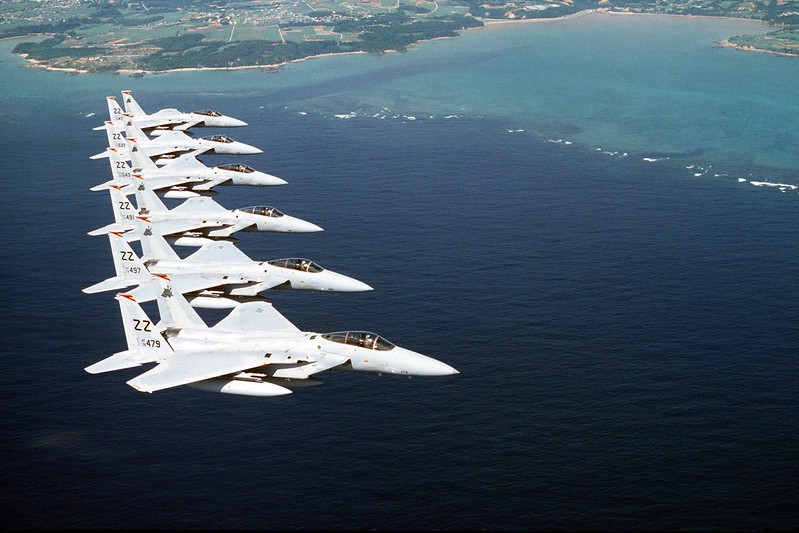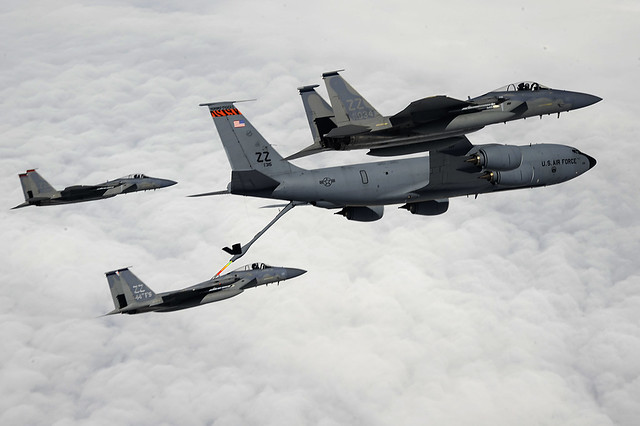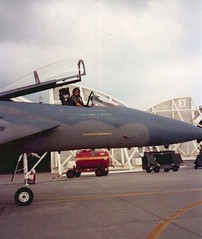This won’t be any kind of organized Air-Minded post, more a collection of thoughts & memories. But there’s a theme, and it’s flying in formation.

You don’t just jump into a single-seat fighter and fly from Japan to Florida. It’s a big operation, not to be sneezed at. I’m not certain where the photo was taken, off the coast of Okinawa or the Florida Panhandle, but I suspect Okinawa. Why? Because you have to be fresh and fully on your game to fly tight formation, so I figure the photo was taken shortly after takeoff from Kadena, probably before the first refueling. After the photo op, the pilots would have spread out into loose formation, easier to maintain for hours on end.
I mentioned refueling, so you know it’s not just the six jets in the photo making the trip. More like ten, including two big air refueling tankers and, at least for the first hour or two of flight, two “air spare” Eagles to take the place of any of the six primaries experiencing problems and having to return to Kadena. And all of you are flying in formation.


The USAF operated two air refueling tanker types in the mid-1980s: the KC-135 Stratotanker and the KC-10 Extender. I’ve flown ocean crossings with both, sometimes both types together … refueling first from a KC-135, then after we’d drained it dry, tapping the boom of a KC-10.
I have a vivid memory of my first time on a KC-10 boom. I’d refueled from KC-135s dozens of times before ever seeing a KC-10. Both tankers feel huge when you’re up under them, but the KC-10 is twice as huge and even though you’re couple of dozen feet below it when you’re in contact position, you feel like you’re in fingertip, counting rivets. Both have director lights on the belly to help you position yourself correctly in terms of right/left, up/down, and forward/aft, but what you really do is look for a general picture, placing the tanker’s belly, right wing root, and right inboard engine in the correct places relative to your canopy bow. When you’ve got the picture right you’re close to the contact position and the boomer takes over, extending the boom past your left shoulder and plugging it into the receptacle (the Eagle’s air refueling receptacle is approximately 18 feet behind and to the left of the pilot).
That first time on a KC-10, I didn’t have any trouble with the visual references, and managed to get into contact position with a minimum of fuss. But wow, the boom on that thing has some muscle. When the boomer plugged me, it felt like tapping bumpers with another car. Then, once attached, it was like being grabbed by the claw on the end of a junkyard crane: when the boomer said “up two” or “left one” it was more of a courtesy call — I was along for the ride and she was going to tug, push, and pull me to where she darn well wanted me.
The USAF is retiring its fleet of KC-10s, replacing them with a Boeing 767-derived tanker called the KC-46 Pegasus. I’m sure the boom on that thing, like the one on the Extender, can pluck you up by the scruff of the neck and put you where you’re supposed to be. When it works, that is!
Another thing about the KC-10. My squadron deployed from Kadena to RAAF Darwin in northern Australia in the early 1990s. We took eight jets and I think around fourteen pilots, plus a few dozen maintenance crews, spare engines and tires, ground equipment, and all the other stuff you need to operate away from home base. Apart from the eight pilots flying the deploying Eagles, everyone and everything else was on the KC-10, which also carried more than enough fuel to get us to Australia. The same KC-10 and its crew stayed with us Down Under, refueling us as we flew long night time missions with our RAAF counterparts, then dragging us all home three weeks later.
On the way down I flew in the jump seat of the KC-10’s cockpit, acting as an airborne supervisor of flying, there in case any of our eight primary Eagle drivers had a problem on the way. Had that happened, I had a headset and a dedicated UHF frequency I could use to help a pilot look up emergency procedures. The maintainers and extra pilots were in the back of the tanker harassing the female boom operator whenever she wasn’t busy refueling our jets.
Anyway, during ground ops at Kadena before takeoff, I was keeping a close eye on things from my position between and just behind the two KC-10 pilots (both majors, one a man and one a woman), listening over the intercom and following along as they went through their checklists. I watched them start number one, then number three. Pretty soon we were taxiing, number two still not running, and I was thinking what a fool I’d look if I reminded them to start it, then how I’d look even more a fool if we tried to take off without it and crashed and died, and was just about to say something when the woman in the right seat reached up and started number two, literally as we turned onto the runway. I guess it’s a DC/KC-10 thing, not running the middle engine on the ground, and I’m sure there’s a sound operational reason for it. Another indelible memory.
 When we flew home to Kadena three weeks later, I piloted one of the F-15s. That’s me taxiing in after landing, the photo taken by my wife Donna, who along with other squadron spouses was waiting on the ramp, there to welcome us home.
When we flew home to Kadena three weeks later, I piloted one of the F-15s. That’s me taxiing in after landing, the photo taken by my wife Donna, who along with other squadron spouses was waiting on the ramp, there to welcome us home.
Some final thoughts about flying formation: military student pilots spend months learning to fly two-ship, then four-ship, formation. Those going on to fighters (but also trainers, bombers, tankers, and anything equipped for aerial refueling) will spend most of their flying days in formation: fingertip, echelon, route, trail, and tactical. You see military pilots flying fingertip or diamond formation at air shows and they make it look like it’s the most natural thing in the world. I’m here to tell you it’s exacting work, requiring constant practice and your full attention. Dangerous, too, especially during rejoins.
The photo of the six Kadena jets at the top of the post? They’re in left echelon with each pilot maintaining three feet of wingtip separation while holding precise fore & aft, up & down positions on the jet alongside. If you could see inside the cockpits, particularly out toward the end of the whip where numbers four, five, and six are flying, you’d see sticks and throttles in constant motion. It’s hard work — and I wish I were doing it, right now.
Reference the photo at the top of this post, a clarifying comment from one of the pilots, Dan Leaf:
“This was actually a dedicated photo flight before departing. I think I’m in 497 – my jet for WT – but I wasn’t #2 on the team, I was #5 (ready spare). Lead was Hawk Taylor, other members were Sperm Perme, Madman Smith, Duke Catton and Hodge Hodgkins. We may have flown this before the lineup was set. Those brain cells are long dead. We did not do well. Everything that could go wrong did – except for Duke who came close to Top Gun award if I remember correctly. The actual deployment was 14.8 from Kadena to Eglin – then flew a short flight to Tyndall a couple of days later.”